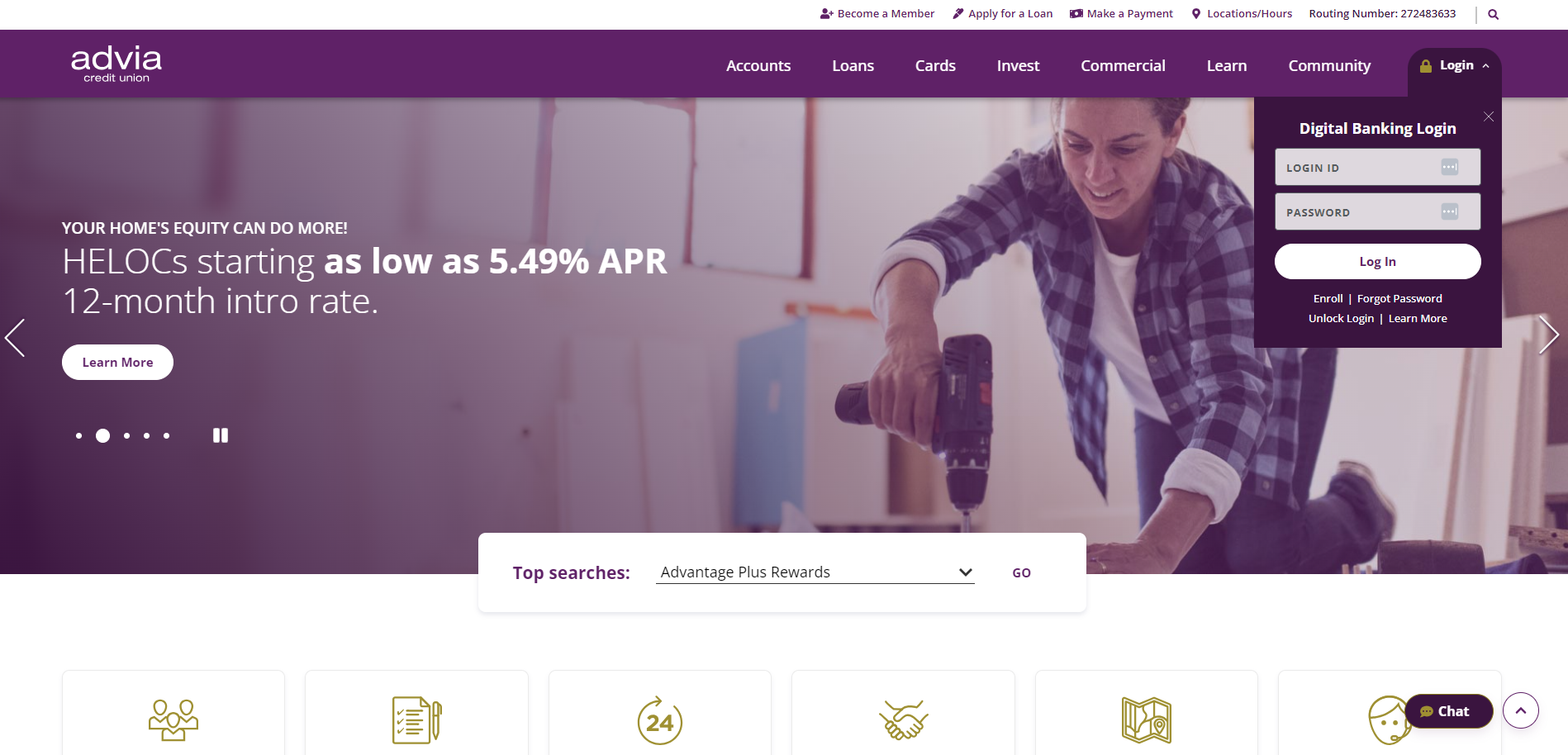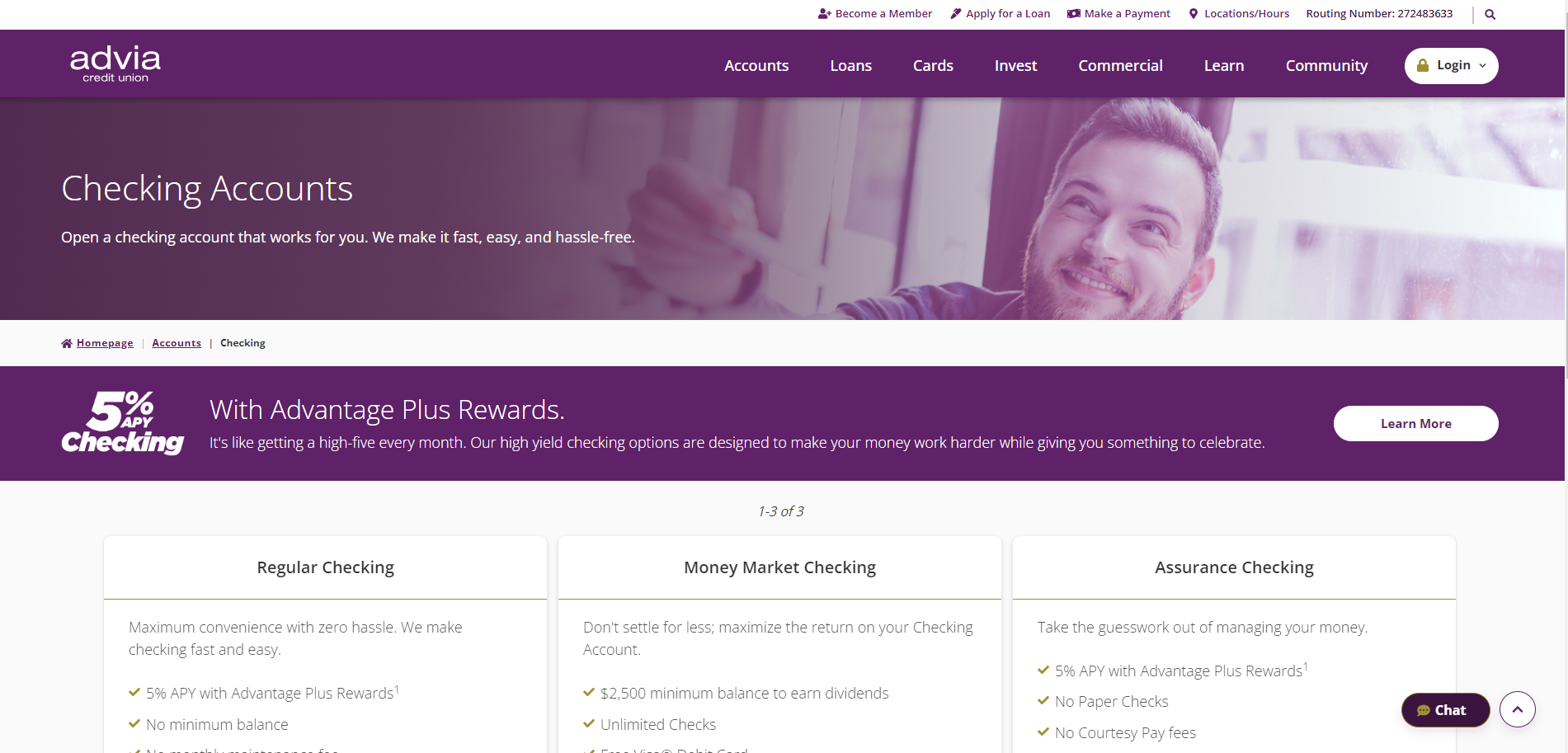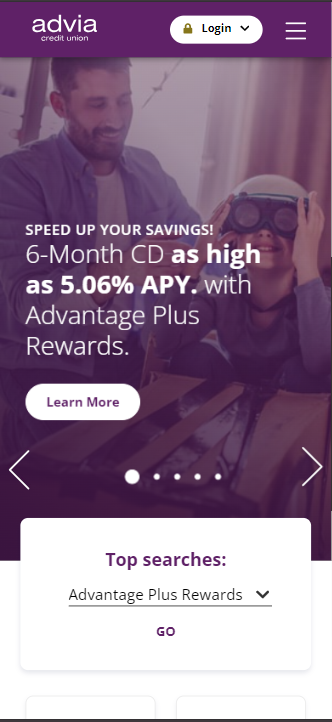ADVIA CREDIT UNION
Services we provide:
- Discovery
- Digital Strategy
- Content Analysis
- Custom Integrations
- UX/UI Design
- Website Development
- Hosting
- Support
About Advia Credit Union
Advia Credit Union has a mission to provide financial advantages to its members by providing advice, advocating for members, and offering advantages other financial institutions don’t. This is accomplished through innovative financial solutions and a new, scalable website. For this new site, Advia sought to proactively provide the quickest and easiest digital solution for members to get the best user experience. Advia is not like other financial institutions; this is illustrated in Advia’s commitment to serving the ever-changing financial needs of its members. One of its core values is to drive progress by engaging in a spirit of innovation and developing new digital service tools for its members. This led to an innovative website redesign to give members easy access to information digitally.
The Challenge
The old website was not intuitive, and the overall digital experience lacked. The lending areas of the old site for both mortgages and auto loans were not producing results. With increased in mobile traffic, the site needed an improved mobile user experience. A major challenge facing Advia’s business team was the organization and content hierarchy of the old site. The content was repetitive and text-heavy, and members were confused about where to find the information they sought. Other obstacles included Advia’s team being unable to easily update the content and structure of the pages on the old website.
Goals for the New Site:
- Improved navigation layout
- Measurable enhancements
- Increase time spent on the website
- Meets brand standards with redesign
- Increase overall visitors engagement
- Increase content management efficiency
Advia wanted to create a “one-stop” resource center to educate members on digital banking—including forms, links, documents, and video tutorials. Two goals for the new Advia Credit Union website were simplifying content and allowing self-service for members. Advia did not want to reinvent the wheel in terms of UI but wanted to deliver a better digital experience to its members and potential new members. The new website provides a clean and clear navigation experience to eliminate clutter and confusion.
The Right Platform
SilverTech reviewed several CMS/DX platforms with Advia. Progress Sitefinity was the chosen platform, giving Advia a fully optimized digital experience. Using the page templates on the Sitefinity platform allows Advia to accomplish the goals for the new site by enhancing the design and layout of the website with ease. The new website improves the user experience with the use of properly placed navigation buttons and call to actions (CTAs) clearly directing users through the content on the page to the sub-pages. Advia’s site has an engaging navigation and advanced filter functionality allowing users to get to the content they are looking for with ease. Additionally, the Advia content team can seamlessly update and create pages within the Sitefinity CMS, keeping the website current and relevant.
RESULTS
Why Your Complex Content Management Solution Could Be Holding Back Your Digital Transformation
4/23/25
When it comes to selecting a content management system, there’s a common instinct to lean toward the industry giants that appear in the top right corner of analyst quadrants. These platforms are often seen as the safest, most validated options, especially for mid-market to enterprise organizations. But while they may look like a reliable choice on paper, they come with significant costs that go far beyond licensing — and those costs deserve closer examination.
Many of these enterprise CMS platforms carry licensing fees well into six figures annually. That’s just to access the platform itself, before creating any content, building workflows, or connecting the system to other parts of your marketing stack. What’s often overlooked is that mid-market CMS platforms, which are substantially more cost-effective, now offer a feature set that covers the same core needs of complex organizations. Multi-site management, multi-language capabilities, advanced personalization, AI-driven insights, workflow automation, integrations with CRMs and marketing tools, and scalable architectures — all of these are available without the need for a six-figure spend. And, all of these solutions would scale to meet the needs of an enterprise business - so while they fit mid-market, they also scale up nicely to enterprise.
The Opportunity Cost of Overspending on Licensing
The argument isn’t just about licensing fees, though. It’s about total cost of ownership and the opportunity cost of tying up budget in technology that, while powerful, may not actually advance the organization’s goals any faster than more affordable alternatives. When that budget is freed up, it can be redirected toward initiatives that have a more direct impact on growth and maturity. Rather than spending heavily just to maintain access to a platform, companies could invest those resources into improving content strategy, expanding personalization efforts, enhancing data analytics capabilities, or even running more aggressive acquisition campaigns.
The Hidden Costs of Some Enterprise Platforms
What complicates matters further are the hidden costs that often come with some large enterprise platforms. These aren’t always immediately visible during the selection process but can quickly accumulate once the platform is in use. Here’s a closer look at where these hidden costs tend to surface:
Hidden Cost | Description | Impact |
Specialized Staffing | Enterprise platforms typically require dedicated, highly specialized technical teams. | Increases operational overhead and complicates hiring and retention. |
Vendor Lock-In | Migration away from these platforms is time-consuming and costly. | Limits future flexibility and locks budgets into ongoing, escalating renewals. |
Complexity Tax | Overly complex systems slow down marketing and content teams. | Reduces agility and delays time-to-market for campaigns and updates. |
Maintenance & Upgrades | Keeping the platform current requires ongoing investment. | Adds continual cost and diverts attention from strategic priorities. |
Training & Enablement | High learning curves demand more time and resources for training. | Prolongs the timeline before teams become fully productive. |
These factors often contribute to a long-term scenario where organizations are not only paying substantial licensing fees but also dedicating ongoing internal resources just to keep the platform running smoothly. Over time, this drains both budget and momentum.
Mid-Market Solutions Are Already Powering Enterprise Success
It’s important to recognize that plenty of enterprise organizations are already seeing success with more agile, mid-market CMS platforms. These solutions are more approachable from a budgetary perspective but still offer the technical depth needed for complex, global digital operations. In many cases, they allow companies to avoid over-investing in infrastructure and instead focus their efforts on advancing their digital maturity in meaningful ways.
What Could Be Done with the Budget Freed from Licensing
When organizations no longer commit a significant portion of their budget to licensing alone, they create room to invest in areas that directly elevate their digital presence and customer engagement. These savings could fund the creation of higher-quality, higher-volume content that keeps pace with audience expectations. They could enable deeper personalization strategies, using data and AI to craft experiences that feel truly tailored to each visitor. Teams could invest in more advanced analytics to uncover customer insights that guide smarter decision-making, or in the expansion of marketing automation to scale outreach without scaling headcount. Freed-up budget also allows for greater flexibility to test new channels, run targeted acquisition campaigns, or experiment with emerging technologies — all of which contribute to advancing digital maturity in ways that static platform costs simply do not.
Focus on What Moves the Needle
The core of the decision comes down to this: the CMS itself is not what differentiates a brand. It’s a foundation, not a growth engine. What matters far more is how an organization leverages its resources to create compelling content, deliver personalized experiences, integrate it within its eco-system and stay adaptable in a fast-changing digital landscape. A simpler, more cost-effective platform can enable exactly that — without sacrificing capability or scale.
By looking beyond the giants in the market that offer many bells and whistles you’ll never use, and will overpay for through the life of your contract, you’ll find plenty of technology-forward mid-market CMS/DXP choices such as Kentico, Sitefinity and Sanity that will deliver everything you need and more (more money back into your budget that is). It’s worth at least taking a look at what they can do. A midmarket solution may be exactly what you need to transform your digital experience while spending less time managing technology, and more time driving meaningful impact.



